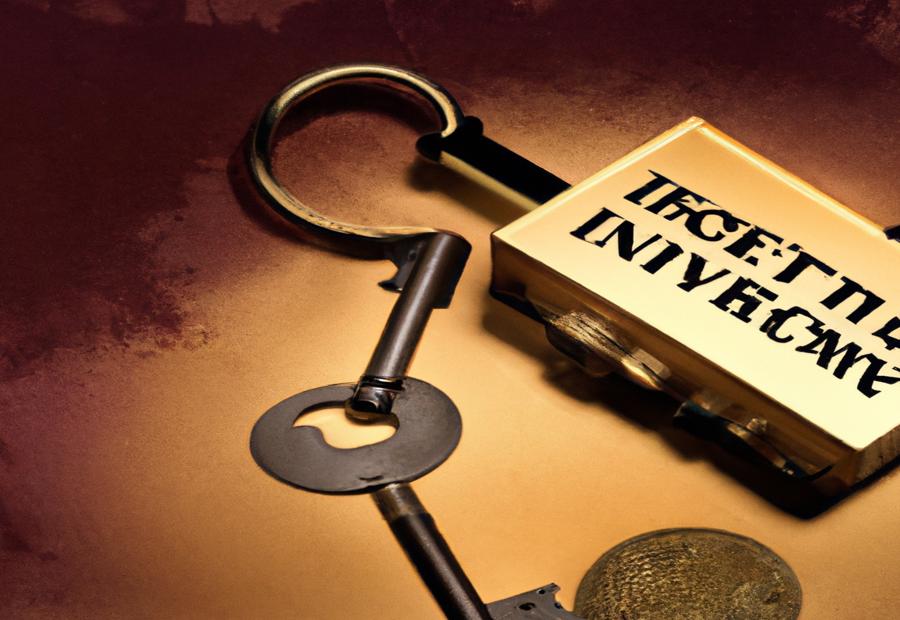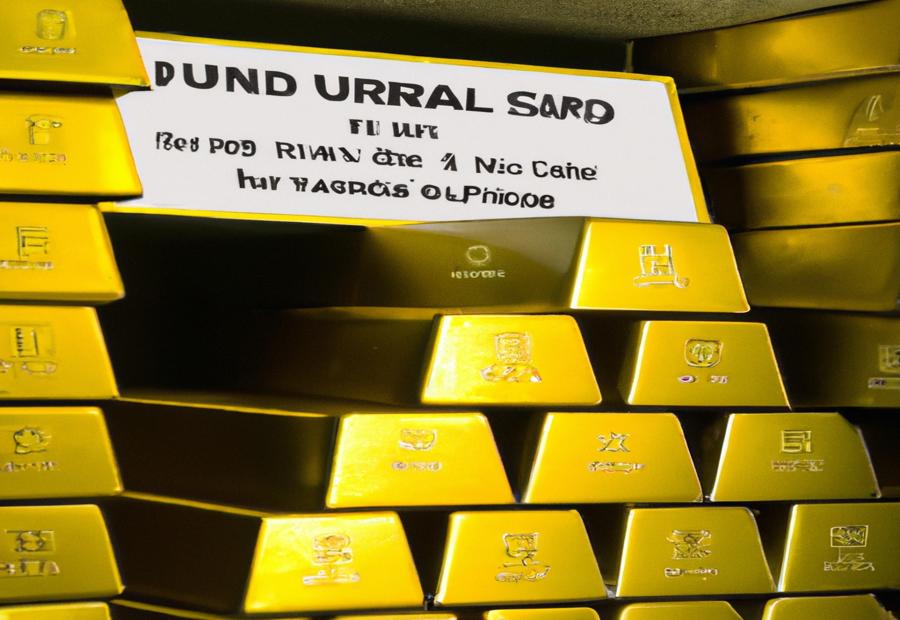.jpg)
Key Takeaway:
- Choosing your own custodian for a self-directed gold IRA is important to avoid hidden fees and costs associated with custodians.
- Investing in gold in a self-directed IRA provides stability and value retention, as well as portfolio diversification beyond stocks and bonds.
- Understanding self-directed IRAs and custodians is essential, including assessing fee structures and investment options.
The Importance of Choosing Your Own Custodian for a Self-Directed Gold IRA

Photo Credits: Bizstone.Com by Keith Lopez
When it comes to self-directed Gold IRAs, choosing the right custodian is crucial. In this section, we will uncover the importance of selecting your own custodian and how it can directly impact your investment. From hidden fees to the overall amount of gold you receive, we will explore the factors that should be considered when making this critical decision. So, buckle up and get ready to take charge of your financial future with a self-directed Gold IRA.
Hidden fees and costs associated with custodians
Custodians of self-directed gold IRAs often come with hidden fees and costs. These can significantly reduce the amount of gold an investor receives. Therefore, it is important to assess the fee structure and investment options a custodian offers before selecting one. Doing so can help avoid unexpected costs and ensure the gold IRA remains profitable.
Investing in gold offers stability and value retention. With a long history of being a safe haven asset, gold has consistently maintained its value. Diversifying a portfolio beyond stocks and bonds further protects retirement savings against market volatility.
A custodian plays a vital role in managing the gold IRA. They must oversee record-keeping, reporting, compliance with IRS regulations, etc. It is important to choose one with competitive pricing and secure storage solutions.
The IRS outlines the rules governing permitted investments in gold IRAs. Investors must adhere to these regulations when selecting gold and other precious metals. Also, ownership and possession rules can be complex.
Options for self-directed gold IRA providers include Madison Trust, Advanta IRA, and Midland Trust. All offer competitive pricing and secure storage solutions.
Opening a gold IRA involves a step-by-step process, including selecting a provider and purchasing gold. This must be done carefully to ensure compliance with IRS regulations and for informed investment decisions.
Gold IRAs have risks and costs. Gold prices can be volatile. There is also the risk of theft or fraud. Setup fees, storage fees, and cash-out costs must be considered.
Tax implications and withdrawal options are also important when investing in gold IRAs. Traditional and Roth IRAs have different tax considerations, and Roth gold IRA withdrawals can be tax-free in certain cases.
Impact of custodian fees on the amount of gold received
Investing in a self-directed Gold IRA? Consider custodian fees. These fees vary and can significantly affect the amount of gold received.
Hidden fees can reduce the value of the investment. Other costs like setup fees, storage fees, and cash-out costs should be considered too.
Check the investment options offered by different custodians. Some provide a wider range of investments, like gold, to diversify your self-directed IRA.
Madison Trust, a provider mentioned in the Reference data, offers competitive pricing and secure storage for gold investments. Find a reputable provider that prioritizes affordability and security.
Benefits of Investing in Gold in a Self-Directed IRA

Photo Credits: Bizstone.Com by Edward Roberts
Investing in gold within a self-directed IRA offers compelling benefits, including stability, value retention, and the opportunity to diversify beyond traditional investments like stocks and bonds. Discover how including gold in your portfolio can provide stability in uncertain economic times and preserve your wealth over the long term, while also expanding your investment horizons beyond the confines of conventional assets.
Stability and value retention of gold
Gold’s track record of value retention over time makes it a reliable and stable investment. Its price tends to remain steady, giving investors seeking stability an attractive option. Plus, with a self-directed IRA, you can diversify your portfolio, reduce risks, and provide a hedge against inflation. But, it is important to remember that gold still has risks, like fluctuations and storage fees. So, add some sparkly insurance against economic calamity to your portfolio and expand your investment horizons – nothing says diversification like gold!
Portfolio diversification beyond stocks and bonds
Gold offers stability and is known for its value retention, especially during economic uncertainty. Unlike stocks and bonds, which can be affected by market changes, gold is historically reliable.
Investing in gold provides a chance to diversify beyond stocks and bonds. Diversifying can help protect against market volatility and any risks from a concentrated portfolio.
Adding gold to your investments also provides a hedge against inflation. As the dollar’s worth decreases, gold’s value typically rises, offering a shield against reducing purchasing power.
It is important to consider other options beyond stocks and bonds for diversification. Including assets like gold can help protect your investments from market crashes and provide stability during times of doubt.
John, a retiree, is an example. He invested solely in stocks and bonds and faced significant losses in his portfolio when the market crashed. Had he diversified his investments to include gold, he could have lessened some of his losses. This shows the importance of diversifying beyond traditional assets for financial security in retirement.
Understanding Self-Directed IRAs and Custodians

Photo Credits: Bizstone.Com by Jonathan Robinson
Self-directed IRAs and their custodians are key to navigating the world of gold investing. Discover the role of a self-directed IRA custodian and learn about the importance of assessing fee structures and investment options. With the right information, you can make informed decisions about your self-directed gold IRA, ensuring a secure and profitable investment strategy.
Role of a self-directed IRA custodian
Mr. Johnson desired to add gold to his retirement portfolio, beyond just stocks and bonds. He searched for the perfect self-directed IRA custodian. He chose Midland Trust, based on their impressive track record and customer service. With their help, he opened a self-directed gold IRA and acquired gold coins to meet IRS regulations. He was secure knowing his investments were protected by an experienced custodian who is aware of the special requirements of gold IRAs.
Importance of assessing fee structure and investment options
The importance of assessing fee structure and investment options in a self-directed gold IRA cannot be overstated. It allows investors to make informed decisions about their retirement plan and maximize returns.
Mr. Smith, an investor nearing retirement, was keen to diversify his portfolio by investing in gold. He researched various custodians, comparing fees and available options. After careful consideration, he chose the one that best aligned with his financial objectives.
Assessing fee structure and investment options involves diligent research and consideration. By minimizing costs and selecting profitable investments within the IRA, individuals can ensure they are maximizing potential gains. Navigating ownership rules and IRS regulations for gold IRAs is like finding a needle in a haystack – the needle made of gold, and the haystack being your retirement savings.
Permitted Investments and Rules for Gold IRAs

Photo Credits: Bizstone.Com by Harold Thompson
Discover the permitted investments and rules that govern self-directed Gold IRAs. Delve into IRS regulations on various types of gold and precious metals, and uncover the complexities surrounding ownership and possession rules. Unravel the guidelines that ensure a secure and compliant journey towards building your retirement portfolio with gold.
IRS regulations on types of gold and precious metals
The IRS has set rules for Self-Directed Gold IRAs. These regulations show which types of precious metals can be kept in an IRA. It’s important to follow these rules when adding gold to an IRA. Keeping track of gold in an IRA is like trying to find Waldo in a jewelry store. So, it’s vital to understand and obey the IRS laws for gold and precious metals in IRAs.
Complex ownership and possession rules
Comprehending these elaborate possession and possession regulations is essential for any person thinking about a self-directed gold IRA. By obeying these regulations, investors can acquire serenity understanding their investments are compliant and secure.
Moreover, elaborate ownership and possession rules also relate to matters such as inheriting a self-directed gold IRA, transferring assets between custodians, or converting a traditional IRA into a self-directed gold IRA. These extra concerns require exact attention and professional assistance to traverse effectively.
Choosing a Self-Directed Gold IRA Provider

Photo Credits: Bizstone.Com by Jonathan Roberts
When choosing a self-directed gold IRA provider, it’s crucial to consider factors such as competitive pricing, secure storage options, expertise in IRA investments, and the potential tax advantages. In this section, we will explore some top providers like Madison Trust, who offer competitive pricing and secure storage, Advanta IRA, known for their expertise in IRA investments and tax advantages, and Midland Trust, specializing in diversifying retirement accounts with precious metals. It’s important to make an informed decision to safeguard and maximize your retirement investments.
Madison Trust: Offering competitive pricing and secure storage
Madison Trust, a provider of self-directed Gold IRAs, is renowned for its competitive pricing and secure storage solutions. With their low rates, investors can maximize their returns while keeping precious metals investments safe. Madison Trust takes pride in offering a reliable platform for those wanting to diversify their retirement portfolios with gold.
By selecting Madison Trust as your custodian, you can benefit from their experience in IRA investments and tax advantages. They understand the complexities of self-directed IRAs and provide investment options to meet your needs. Furthermore, Madison Trust ensures secure storage, allowing you to rest easy knowing your gold assets are safe from theft or damage.
What makes Madison Trust stand out is their commitment to customer support and education. They go beyond competitive pricing and secure storage by providing resources and guidance to help investors make informed decisions. This dedication is what sets them apart from other self-directed Gold IRA providers.
In “The Importance of Choosing Your Own Custodian for a Self-Directed Gold IRA”, Madison Trust is mentioned among the reputable companies in the industry for their competitive pricing and secure storage solutions for self-directed Gold IRAs.
Advanta IRA: Expertise in IRA investments and tax advantages
Advanta IRA is a leader in the IRA investments field. They specialize in maximizing tax advantages associated with IRAs to help investors benefit their retirement savings. Their experience and knowledge of how IRAs work allows them to guide clients in making smart investment decisions that match their financial goals while reducing tax implications.
Moreover, Advanta IRA provides valuable insights into the tax advantages connected to these accounts. They comprehend the complexities of the tax code and can help clients understand regulations for compliance, as well as take advantage of deductions or exemptions.
From understanding contribution limits to decoding eligibility requirements for different types of IRAs, or optimizing withdrawals for tax efficiency, Advanta IRA is the go-to resource for all. Their focus on delivering top-notch service and guidance tailored to individual retirement goals makes them a trusted partner in self-directed IRAs.
They offer comprehensive solutions to empower individuals to make sound decisions about their financial future. Unlock the full potential of self-directed IRAs and maximize long-term wealth accumulation strategies with AdvantaIRA.
Midland Trust: Diversifying retirement accounts with precious metals
Diversifying retirement accounts with precious metals is a wise move. Midland Trust, one of the top providers in the field, specializes in helping individuals include them in their self-directed IRAs. They offer expertise and guidance on investments and tax advantages, plus competitive pricing for fair value.
They understand the stability and value retention properties of gold, making it an appealing choice for risk-averse folks. Including gold can reduce risks associated with market fluctuations and secure retirement funds.
Midland Trust also helps clients navigate complex ownership and possession rules set by the IRS. With their knowledge and experience, they help clients diversify their retirement accounts with precious metals while complying with all regulations.
Opening a Self-Directed Gold IRA and Purchasing Gold

Photo Credits: Bizstone.Com by Peter Sanchez
When it comes to open a self-directed gold IRA and purchasing gold, there are important steps to follow. We’ll delve into the step-by-step process of opening an account with a provider, and also explore how to select and purchase gold utilizing IRA funds. From understanding the paperwork involved to choosing the right gold products, this section will guide you through the essential aspects of acquiring a self-directed gold IRA and investing in gold.
Step-by-step process for opening an account with a provider
To open a Self-Directed Gold IRA account, there is a step-by-step process. This guarantees that all the necessary requirements and documents are ready before investing in gold through an individual retirement account.
- Research and find a reliable provider that offers self-directed IRA services. Examples of these are Madison Trust, Advanta IRA, and Midland Trust.
- Contact them to start the account opening process. This usually includes filling out an application form from the provider.
- Submit the application. The provider will then check the data and make sure all needed paperwork is in order. This could include ID documents, social security number/taxpayer identification number, and more.
- After the account is opened, put assets into the account to buy gold. This can be done through cash contributions or transferring money from another retirement account.
It is recommended to follow the instructions given by the chosen provider during the account opening process. Different providers may have different processes.
Selecting and purchasing gold with IRA funds
- Research and select a reputable self-directed IRA custodian that allows investments in physical gold. Factors such as fees, investment options, and customer reviews should be considered.
- Open a self-directed IRA account specifically designated for investing in precious metals like gold. Follow the necessary steps provided by the chosen custodian to complete the account opening process.
- Fund the IRA account by transferring funds from an existing IRA or contributing new funds. Make sure the amount is within the IRS contribution limits.
- Select an authorized gold dealer who meets the IRS criteria for acceptable precious metal investments within an IRA. Check the credibility, reputation, and compliance of the gold dealer with relevant regulations.
- Purchase approved gold bullion or coins that meet the IRS requirements for inclusion in an IRA. The custodian will guide investors through the transaction process using the funded self-directed IRA account.
- Ensure the gold is stored securely in compliance with IRS guidelines regarding the possession of precious metals held within an IRA.
This guide covers the basics of selecting and buying gold with IRA funds. For personalized guidance and to ensure compliance with all applicable rules and regulations, it is recommended to consult a qualified financial professional or tax advisor. Investing in gold has the potential to provide individuals with tangible assets that have shown resilience during times of economic uncertainty.
Lastly, it’s important to be aware of the occasional volatility and need to ensure the security of one’s gold, as thieves may have their eye on it.
Potential Risks and Costs Associated with Gold IRAs

Photo Credits: Bizstone.Com by Gregory Rodriguez
Gold IRAs offer individuals the opportunity to diversify their retirement portfolios with the precious metal. However, it’s crucial to understand the potential risks and costs associated with this investment option. In this section, we will explore the volatile nature of gold, the risk of theft or fraud, as well as the fees and costs involved, such as setup fees, storage fees, and cash-out costs. By examining these factors, you can make an informed decision about whether a gold IRA aligns with your financial goals.
Volatility and potential for theft or fraud
Gold market volatility carries the potential danger of theft or fraudulent activities. Its price can change drastically, resulting in losses if not monitored. Gold is tangible and can be stolen. So, it is important to choose a secure storage facility or custodian. Fraudsters may target individuals investing in gold, so one must research and pick reputable providers to reduce the risk of being scammed.
Investors must be aware of the risks involved in gold IRAs. Volatility due to price shifts can cause gains or losses. Thus, it is essential to monitor the market and make decisions based on risk tolerance and investment objectives.
Gold has great value and portability, making it an ideal target for theft or fraud. To avoid this, select a trustworthy custodian or storage facility with robust security protocols. Due diligence on custodians can lower the risk of theft or fraud.
In conclusion, gold IRA setup offers investment opportunities. However, one must understand the volatility and risks involved in the gold market. By staying informed, researching, picking reliable providers and custodians, investors can reduce the chances of falling victim to theft or fraud and make decisions that suit their investment goals.
Fees and costs including setup fees, storage fees, and cash-out costs
Fees and costs for setting up and managing a self-directed gold IRA can greatly affect the overall investment. Examples include setup fees, storage fees, and cash-out costs. Investing in this type of IRA means being aware of these expenses and carefully considering them.
The following table shows different types of fees associated with a self-directed gold IRA:
| Type of Fee | Explanation |
|---|---|
| Setup Fees | Fees charged for opening a self-directed gold IRA account. Usually a one-time fee that covers administrative costs. |
| Storage Fees | Fees for keeping physical gold in an authorized depository or storage facility. The amount of gold stored and the provider chosen affects the cost. |
| Cash-out Costs | Costs when liquidating or withdrawing funds from a self-directed gold IRA. This can include transaction fees or IRS penalties. |
Investors must assess these fees and costs before deciding on a self-directed gold IRA. Proper planning and considering these expenses can help determine the long-term profit of precious metals investments.
Custodians like Madison Trust, Advanta IRA, and Midland Trust may offer competitive fees and secure storage options for gold. They also provide expertise in IRA investments and tax advantages which can benefit investors.
It’s important to know the risks that come with investing in gold IRAs, such as volatility, theft, or fraud. Also, financial implications of the fees and costs must be considered to ensure they fit an investor’s retirement plan goals.
So, if you want to take advantage of golden opportunities, be sure to traverse the tax maze and withdraw responsibly from your self-directed gold IRA.
Tax Implications and Withdrawal Options for Gold IRAs

Photo Credits: Bizstone.Com by Austin Allen
When it comes to tax implications and withdrawal options for gold IRAs, there are important factors to consider. We’ll explore the traditional and Roth IRA tax considerations, as well as the enticing prospect of tax-free withdrawals from Roth gold IRAs. So, buckle up and get ready to navigate the financial landscape of self-directed gold IRAs with insight into tax benefits and withdrawal strategies.
Traditional and Roth IRA tax considerations
It’s essential to think about tax effects when looking into Traditional and Roth IRA plans for retirement. Evaluation of these considerations is key when preparing for your golden years.
Tax-free withdrawals from Roth gold IRAs
Text:
Self-Directed Gold IRAs offer a range of advantages for retirement planning. Tax-free withdrawals from a Roth gold IRA are particularly beneficial. Account holders can make contributions with after-tax dollars and enjoy tax-free growth and withdrawals in retirement.
This provides higher returns and greater control over one’s savings.
Plus, diversifying beyond traditional assets like stocks and bonds is possible.
Gold has historically been a store of value and a hedge against inflation, making it a smart choice for retirement savings.
Working with a reputable self-directed IRA custodian is essential to ensure compliance with IRS regulations.
Estate planning benefits are an added bonus, as beneficiaries can inherit the account and continue to enjoy tax-free withdrawals.
Explore the potential benefits of Roth gold IRAs today!
Conclusion: Evaluating the Suitability of a Self-Directed Gold IRA for Your Retirement Plan

Photo Credits: Bizstone.Com by Richard Rivera
Evaluating a self-directed gold IRA for your retirement plan? Consider your financial goals, risk tolerance, and investment knowledge. A trusted financial advisor can help you decide if it aligns with your retirement strategy.
Gold is historically a safe haven asset, protecting wealth from market volatility and inflation. Act now and don’t miss out on diversifying your retirement portfolio. Consult with a financial advisor and explore your options. Start planning for your future today!
Some Facts About Self-Directed Gold IRAs:
- ✅ Investing in gold in a self-directed IRA allows for portfolio diversification beyond stocks and bonds. (Source: Team Research, IRA Financial Group)
- ✅ Gold IRAs have become popular as a hedge against stock market downturns and inflation. (Source: Team Research, Investopedia)
- ✅ Gold IRAs require a custodian or trustee to hold and manage the gold. (Source: Team Research, IRA Financial Group)
- ✅ Custodians may offer different fee structures, so it’s important to compare prices and fees across multiple companies. (Source: Team Research, Forbes)
- ✅ Precious metals, including gold, must meet specific IRS regulations to be held in a self-directed IRA. (Source: Team Research, Advanta IRA)
FAQs about Self-Directed Gold Iras
Question 1: What is a Self-Directed Gold IRA?
Answer: A Self-Directed Gold IRA is a retirement account that allows individuals to invest in physical gold and other precious metals. It provides the same tax advantages as a standard IRA but offers the added benefit of being able to invest in tangible assets.
Question 2: What are the advantages of investing in a Self-Directed Gold IRA?
Answer: Investing in a Self-Directed Gold IRA can act as a hedge against inflation, provide diversification for retirement portfolios, and offer tax advantages for retirement savings. Gold has historically retained its value and tends to increase in price during times of economic turmoil.
Question 3: What are the fees associated with a Self-Directed Gold IRA?
Answer: The fees for a Self-Directed Gold IRA can include setup fees, annual fees, monthly fees, account valuation fees, and potential cash-out costs. It is important to carefully consider and compare the fees associated with different providers.
Question 4: What types of assets can be held in a Self-Directed Gold IRA?
Answer: A Self-Directed Gold IRA allows for investment in physical gold, silver, platinum, and palladium bullion or coins. However, it is crucial to be aware of the IRS-approved assets and the specific fineness requirements for each type of metal.
Question 5: How do I set up a Self-Directed Gold IRA?
Answer: To set up a Self-Directed Gold IRA, individuals need to establish a self-directed IRA account with a custodian specializing in alternative assets. They will also need to work with a trusted metals dealer and select an approved depository for secure storage.
Question 6: What are the taxation rules for a Self-Directed Gold IRA?
Answer: The taxation of a Self-Directed Gold IRA depends on whether it is a Traditional or Roth IRA. Traditional gold IRAs are taxed as ordinary income upon withdrawal, while Roth gold IRAs allow for tax-free withdrawals. It is advisable to consult a tax professional for personalized guidance.
